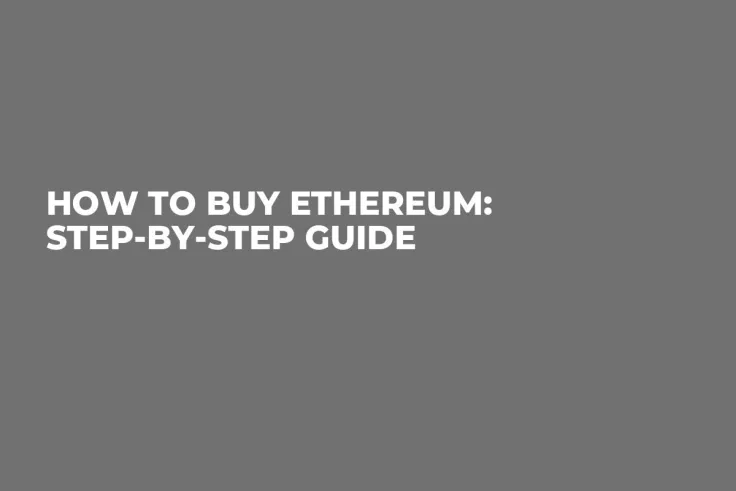
Disclaimer: The opinions expressed by our writers are their own and do not represent the views of U.Today. The financial and market information provided on U.Today is intended for informational purposes only. U.Today is not liable for any financial losses incurred while trading cryptocurrencies. Conduct your own research by contacting financial experts before making any investment decisions. We believe that all content is accurate as of the date of publication, but certain offers mentioned may no longer be available.
Ethereum (ETH), the second-largest cryptocurrency in the world, is still among the top picks for altcoin holders and all crypto fans. Inching closer to the 10-year anniversary of its mainnet, it triggers hot discussion in the community.
In this longread, U.Today will explain how to buy the Ether cryptocurrency with crypto or fiat, and what alternatives should be considered in 2025.
What is Ethereum (ETH) and how to buy it: Quick facts
Ethereum (ETH) is the first-ever blockchain with smart contracts functionality, while ETH or Ether is its core cryptocurrency.
- Ethereum (ETH) is a programmable blockchain that supports smart contracts, isolated self-executed software programs.
- Launched in mainnet July 30, 2015, Ethereum (ETH) was the first blockchain with smart contract functionality.
- Ether or ETH is Ethereum's internal cryptocurrency that is used for network fees and staking rewards.
- The Ethereum (ETH) blockchain remains the backbone element of tens of Layer-2 blockchains based on Ethereum Virtual Machine (EVM).
- Ether is the second largest cryptocurrency by market capitalization, which means it is only surpassed by Bitcoin by market cap.
- Ether can be purchased on centralized and decentralized exchanges with fiat and crypto payment instruments.
In 2025, the Ether (ETH) cryptocurrency can be purchased with ease even with no previous experience in blockchain and trading.
How to buy Ethereum on Binance
To buy the Ethereum (ETH) crypto with fiat, you need a valid account on a centralized exchange and some money — it can be a familiar PayPal account or just a credit card of Visa, MasterCard, or UnionPay ecosystems.
- Set up an account and complete KYC. Register and validate your account, and share your personal information so that the exchange is able to check your ID and registration address.
- Choose the “Buy Crypto” menu and set up exchange details. For instance, here is how the “Buy Crypto” option looks on Binance once you choose to purchase 0.6 Ether for 1,000 U.S. dollars.
- Authorize the exchange and wait for the coins to arrive. Normally, after the approval of the deposit by your bank or payment processor, the coins arrive in your wallet in three to five minutes.
Please note that the “Buy Crypto” option, while being the most user-friendly one, comes with greater fees and might not be available for cardholders in certain regions.
How to buy Ether: Step-by-step guide
Now we are ready to dive deeper into the methods of purchasing the Ether cryptocurrency with other cryptos or fiat on CEXes or on decentralized exchanges.
How to buy Ethereum on CEXes
To buy the Ethereum cryptocurrency on centralized exchanges (like Binance or Coinbase), you need to complete four steps.
- Set up an account and pass KYC checks. Normally, in 2025, centralized exchanges require an e-mail address, a phone number, a scanned copy of ID and a photo of the potential client. All these steps can be done via either a desktop computer or a smartphone with a camera and an installed exchange application.
- Top up the account with money. You need to obtain Bitcoin (BTC), U.S. Dollar Tether (USDT) or any other cryptocurrency you would like to buy Ethereum (ETH) with. Think of that as your medium of exchange here. You can ask someone to drop BTC or USDT to your account (via the “Deposit” function) or buy it yourself for cash or on P2P exchange platforms.
- Find the trading pair and authorize the exchange. This is how the ETH for USDT exchange interface looks on Binance, the world’s largest crypto exchange.
Users can choose a Spot Buy amount or set “MAX” to spend all USDT for purchasing Ether. Then, orders will be placed and money will appear in the user's trading account in seconds.
How to buy Ethereum on DEXes
Buying Ethereum on decentralized crypto exchanges like Uniswap or Aave remains the only option to avoid KYC procedures.
- Set up your on-chain wallet. DEXes are basically interfaces that streamline the interactions between on-chain (non-custodial) crypto wallets. As such, to buy crypto on a DEX, you need to set up one. MetaMask and TrustWallet are the most mainstream options.
- Top up your wallet with money (USDT or USDC) and bond it to the interface. Just like in the CEX-focused manual, you need to share your wallet address with someone to allow them to send you some money.
Here’s how you connect your wallet with Uniswap’s interface.
- Set up the exchange pair and initiate the exchange. Choose the crypto you’d like to spend (USDT or USDC for instance), the amount you want to spend on ETH, and authorize the swap.
Please note that cryptocurrency operations on DEXes depend on exact network load at any given moment. As such, during peak market activity, transactions can be delayed.
What is Ethereum and what makes it special?
Ethereum (ETH) is a blockchain (decentralized network) with smart contracts support. Ethereum (ETH) acts as a global multi-purpose distributed computer. Launched in 2015, it introduced a powerful concept, i.e., a programmable blockchain that supports decentralized applications (dApps), ranging from DeFi to GameFi projects, wallets and DAOs.
Ethereum (ETH) was the first mainstream blockchain that went beyond sending and storing crypto. Earlier blockchains like Bitcoin, Litecoin and XRP Ledger only allowed users to transact and store value in crypto. By contrast, Ethereum (ETH) paved the way for a completely new segment of blockchain-based applications.
The popularity of Ethereum (ETH) triggered hype around altcoins, which was the core catalyst for the 2016-2017 bull run, 2020 DeFi Summer and 2021 Meme Coin Mania.
Why is Ethereum still popular in 2025?
As of 2025, Ethereum remains popular because of its strong developer community, continuous upgrades and wide adoption. Key improvements like the transition to proof of stake (PoS) and the Ethereum 2.0 upgrades have significantly reduced energy usage and improved scalability.
Then, Layer-2 networks (e.g., Arbitrum, Optimism, Base) enhance transaction speed and lower fees. Ethereum (ETH) also achieved notable developer-friendliness. It leverages the Solidity programming language as well as ether.js and Web3.js libraries.
Ethereum is also a trusted foundation for innovation since many top blockchain projects are built on or compatible with it. Its long-standing reputation, active ecosystem and adaptability to evolving Web3 demands ensure its ongoing relevance and leadership in the crypto space. In short, Ethereum powers much of today’s decentralized applications ecosystem.
Ethereum (ETH) price 2025: Two scenarios
In 2025, Ethereum (ETH) is heavily underperforming compared to Bitcoin (BTC) and all major altcoins. It is yet to be seen whether it is able to break the trend and reach a new price high.
Bullish Ethereum (ETH) price 2025 scenario
Despite the aggressive selling pressure and much criticism in 2025, Ethereum still has a number of powerful catalysts that can kickstart an ETH price rally again. First, Ethereum is the only altcoin with spot exchange-traded funds (ETFs) approved in the U.S. and Hong Kong. It ensures the constant inflow of liquidity into the Ethereum (ETH) ecosystem.
Ethereum (ETH) remains the largest smart contracts platform (programmable blockchain) by a number of factors. Simply put, it is “too big to fail”: Ethereum (ETH) is the biggest smart contract blockchain by total value locked (TVL) in DeFi protocols, it hosts the largest number of decentralized applications by far and continuously attracts new dApps.
Also, Ethereum (ETH) is the technological and economical backbone of Layer-2 blockchains, including Base, Arbitrum, Polygon, Blast, zkSync, Optimism. It means that they verify all transactions on Ethereum’s mainnet.
This combination of economical and technological factors creates a massive “ecosystem effect” that makes Ethereum (ETH) an outstanding and reliable investment for years to come.
Bearish Ethereum (ETH) price 2025 scenario
In 2025, Ethereum (ETH) has too many competitors with bigger potential upsides. Ethereum (ETH) has lower transaction speed compared to Solana (SOL) and its own L2s like Polygon (POL), Optimism (OP) and Arbitrum (ARB).
By some experts, Ethereum (ETH) is considered to be too conservative, which results in major upgrades being postponed.
But, most dangerously, ETH's price correlation with the utility of Ethereum as a blockchain still remains nuanced. By some theories, Ether is perceived as tech stock and not as a store of value, which damages the narrative building.
Last but not least, Ethereum spot ETF launch in Q3, 2024, was outshined by Bitcoin’s spot ETFs, which launched in January 2024. Ether-based products failed to attract liquidity that can be compared to Bitcoin's. There is a theory that all liquidity by potential investors interested in crypto ETFs was siphoned by spot Bitcoin ETFs in the U.S.
Ethereum (ETH) blockchain: Key rivals
In 2025, Ethereum (ETH) is competing with a plenty of large-cap altcoins, while Solana (SOL), Cardano (ADA) and XRP are the largest of them.
XRP
Ripple-linked XRP is the core native cryptocurrency of XRP Ledger, one of the oldest blockchains. The blockchain was introduced in June 2012 by David Schwartz, Jed McCaleb and Arthur Britto. It was designed for fast, low-cost international payments. Soon after, they co-founded Ripple Labs to promote XRP’s adoption by banks and financial institutions.
Ripple uses XRP within its internal business mechanisms as a payment method and the instrument of liquidity logistics.
XRP faced regulatory pressure starting in 2020, when the U.S. SEC filed a lawsuit against Ripple, claiming XRP was an unregistered security. In 2023, a U.S. court ruled that XRP is not a security when sold on exchanges, a partial win for Ripple.
The XRP Army is a passionate online community that actively supports XRP, defends it in public debates and promotes its broader adoption.
Solana (SOL)
Solana is a high-performance blockchain launched in March 2020, founded by Anatoly Yakovenko and Raj Gokal. It uses a unique hybrid consensus model combining proof of history (PoH) with proof of stake (PoS), enabling extremely fast and low-cost transactions.
Unlike Ethereum, Solana processes thousands of transactions per second with minimal fees, thanks to its high throughput design. Solana prioritizes speed and scalability, making it ideal for real-time applications.
Solana has become a hotspot for meme coins, driven by low fees and easy deployment, especially on platforms like Pump.fun, which lets users quickly launch and trade tokens with minimal effort.
Solana was heavily affected by the FTX/Alameda collapse in 2022 due to close ties, but it rebounded strongly, supported by a loyal developer community and rising interest in its growing ecosystem.
Cardano (ADA)
Cardano is a decentralized blockchain platform launched in 2017, founded by Charles Hoskinson. It focuses on a scientific, peer-reviewed approach to development and aims to deliver a secure and scalable platform for smart contracts and dApps.
Cardano uses a proof-of-stake protocol called Ouroboros, involving delegators, who stake their ADA to support the network, and staking pool operators, who maintain its infrastructure. ADA is Cardano’s native cryptocurrency, used for transactions, staking and governance.
Major steps toward decentralization include Shelley (staking and delegation), Goguen (smart contracts) and the upcoming Voltaire phase, introducing on-chain governance. The Cardano Constitution, being developed by the community, will guide future governance.
Key upgrades include the Vasil hard fork (2022), improving performance and smart contract efficiency, and Chang hard fork, crucial for the decentralization status.
Closing thoughts
In 2025, Ethereum (ETH) will remain a mainstream cryptocurrency and the second digital asset by aggregated market capitalization. Ether can be purchased on exchanges, both centralized and decentralized. On major CEXes, Ethereum can be bought with either crypto or fiat money.
 Dan Burgin
Dan Burgin Vladislav Sopov
Vladislav Sopov U.Today Editorial Team
U.Today Editorial Team